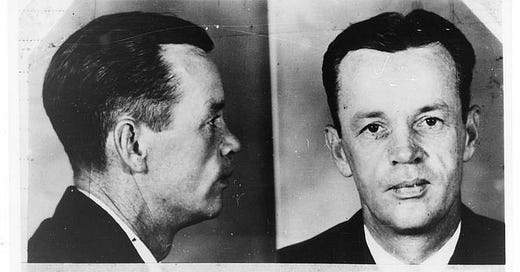1950 — FBI’s Ten Most Wanted Fugitives List Begins
public domain image from wikimedia commons
On this date in 1950 (seventy-five years ago), the FBI began compiling and publishing its list of who it considered to be the ten most wanted fugitives from justice. To make the list, factors that come into play are being a career criminal (having a lengthy police record), posing a danger to the public, and the belief that publicizing the fugitive from justice’s name and likeness has a good chance of leading to somebody recognizing them and reporting their whereabouts.
The first person added to the list was Thomas James Holden, who had killed his wife and her two brothers in Chicago, Illinois, on June 5, 1949. A little over a year after being added to the list, and a little over two years after the murders (on June 23, 1951), Holden was arrested in Oregon after police received a tip.
Another of the first ten on the list was the man pictured above, Henry Harland Shelton. He was also arrested on June 23, but in his case it was in 1950, only three months after becoming infamous due to his inclusion on the most wanted list.
More than 150 members of this “scream team” have been arrested as a result of help from the public. Being apprehended is one way a person can be removed from the list; the other common way is to die.
Questions: Have you ever seen an “FBI Most Wanted List” in a post office (or elsewhere)? How many people have been on the list? How many of these were eventually captured (so far)? How many were never captured (as of now)?
1988 — First Official Pi[e] Day
photo by me, taken today
Pi (a “mathematical constant”) is a non-ending real number, meaning it cannot be resolved to an absolute value with no further decimals.
In other words, you can never say, “this is the precise value of pi,” as you can always add another decimal to it for more accuracy. This is similar to how you will never reach absolute 0/zero when halving a value over and over again.
In a shortened form, Pi can be expressed as 3.14159 — or, in an even more truncated way, as 3.14 (the latter expression, with only two decimal places, makes the most sense as far as Pi Day [3/14] goes).
If you cut a pie (apple, banana, blackberry, cherry, gooseberry, pumpkin, strawberry-rhubarb, or what have you) into 32 same-sized pieces, and ate just one of them (who could really do that?), you would have eaten pi percent of the pie — very nearly so, anyway, as 1/32 of a pie is 3.125% of it. I can tell you with absolute certainty that I will eat more than pi of the above pie today.
On this date in 1988, math geek enthusiast Larry Shaw (1939-2017) instituted the first official Pi Day at the Exploratorium in San Francisco, California, where he worked.
Questions: What is your favorite kind of pie? Do you consider Pizza to be a type of pie? Why is Pi an important number? What is Pi’s relationship to the circumference (distance around) and diameter (distance through) of a circle? What is the Exploratorium? Have you ever been there?









